Exploring the Potential of Model Making in Developing Students Understanding and Creativity in Structural Studies
DOI:
https://doi.org/10.24191/idealogy.v3i1.49Keywords:
Model Making, Dollhouse, Building Structural Studies, CreativityAbstract
Nowadays, developing students understanding and creativity through traditional instruction may need an extensive consideration. In recent years, expeditiously increasing needs in flexibility of learning which involved interaction in between convergent and divergent thinking. In order to encourage students' attentiveness and understanding on building structural studies, a prototype model so called Doll House Project has been introduced. The student needs to build the doll house by integrating mathematical formulae and building construction syllabus. This research intends to study on the potential of model making in developing students understanding and creativity in structural studies. Therefore, an experimental study has been conducted for 30 numbers of architecture students and divided into six (6) groups. Thus, the impacts of this prototype on the achievement will be measured and identify how well the students truly understand the course material. The method to develop a structural design understanding is by constructing a model of a dollhouse by each group and prepares reports individually on preparation and calculation of the dollhouse. The outcome from this exercise is that the students understand mathematics theory and application through scaled model. Hence, the students’ performance in understanding reinforced concrete structural design is improved with the experimental learning the mathematics and injection of creativity.
Key Words: Model Making, Dollhouse, Building Structural Studies, Creativity
References
Idris, N., & Nor, N. M. (2010). Mathematical creativity: usage of technology. Procedia-Social and Behavioral Sciences, 2(2), 1963-1967.
Inan, C. (2013). Influence of the Constructivist Learning Approach on Students' Levels of Learning Trigonometry and on Their Attitudes towards Mathematics. Hacettepe Üniversi-tesi Eğitim Fakültesi Dergisi, 28(28-3).
Jarmon, L., Traphagan, T., & Mayrath, M.C. (2008). Understanding project- based learning in Second Life with the pedagogy, training and assessment trio. Education Media Interna-tional 45(3), 157–176
Morris, M. (2006). Models: Architecture and the Miniature Volume 6 of Architecture in Practice (illustrate). Wiley.
Nayak, D. K. (2007). A Study on Effect of Constructivist Pedagogy on Students’ Achieve-ment in Mathematics at Elementary Level. National Institute of Open Schooling, MHRD, Noida.
Simonton, D. K. (2000). Creativity: Cognitive, personal, developmental, and social aspects. American psychologist, 55(1), 151.
Wilson, B. G. (1995). Metaphors for instruction: Why we talk about learning environments. Educational Technology, 35 (5), 25-30.
Zanzali, N. A. A. (2000). Designing the mathematics curriculum in Malaysia: Making math-ematics more meaningful. Universiti Teknologi Malaysia, Skudai
Downloads
Published
Issue
Section
License
UiTM Press (the Publisher) has agreed to publish the undersigned author’s paper in Idealogy Journal. The agreement is contingent upon the fulfilment of a number of requirements listed below.
1. The undersigned author warrants that the paper entitled below is original, that it is not in any way libellous or unlawful in Malaysia, that it does not infringe any copyright or other proprietary right. The undersigned hereby represents and warrants that he/she is the author of the paper, except for material that is clearly identified as to its original source, with permission notices from the copyright owners where required. The undersigned represents that he/she has the power and authority to sign and execute this agreement.
2. The undersigned author warrants that the paper entitled below has not been published elsewhere, and also it will not be submitted anywhere else for publication prior to acceptance/rejection by this Journal.
3. By submitting the paper entitled below, the undersigned author agrees to transfer the rights to publish and distribute the paper in an international e-journal (entitled above) to Publisher.
4. The undersigned author agrees to make a reasonable effort to conform to Publisher's submission guidelines and to liaise with the editor to ensure that the requirements of these guidelines are met to a reasonable degree.
5. The corresponding author signs for and accepts responsibility for releasing this material on behalf of any and all coauthors. This agreement is to be signed by at least one of the authors who has obtained the assent of the co-author(s) where applicable. After submission of this agreement signed by the corresponding author, changes of authorship or in the order of the authors listed will not be accepted.




